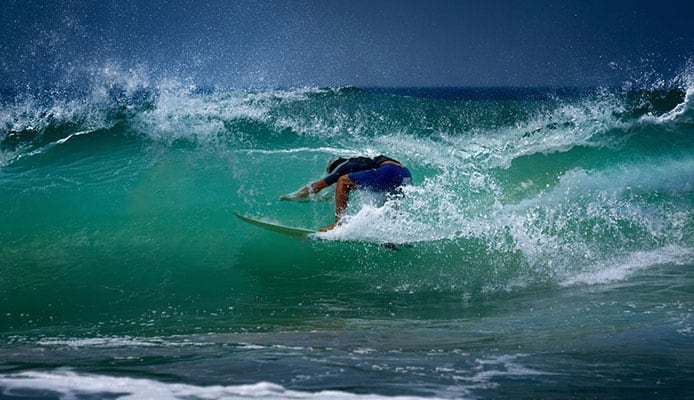
It can safely be assumed that the first people to think of using a board to surf the waters had to put up with a lot of bumps on their bodies afterward. What we can learn safely, they had to do it practically.
Being drilled by a 3-meter high wave, with no GPS trackers then, and in the middle of nowhere, was always a chilling episode to those pioneers.
Any surfer who was not lucky to kick out or boost away from an angry barrel had to roll into the deep. If you wish to ride on the high waves without the trouble these earlier wave riders went through, sift through the following tips on how to survive a surfing wipeout. These will give you the confidence you need to navigate through the waves safely. So here we go…
1. Protect Your Head
Without the benefit of a mask for swimmers, a surfer has to devise a way of protecting his much-needed brain in times of stressful situations like wipeouts. Centuries-old instincts always tell us to curl in a fetal position when we huddle for sleep and so should you if you wish to be a wipeout survivor. It is the best way of protecting the most vital organs of your body.
Curl up as you dive under the wave, so you are not swept toward the beach. This will protect you from being knocked unconscious by reef projections or other surfboards free in the water, or even from being strangled by leashes.
2. Wait For The Jiffy To Pass
Most of the waves have a passing period of 2 to 20 seconds. This is the perfect time to relax as you plan your next move. This is important as it enables you to recover quickly.
Your instincts at this time will guide you on the location of your surfboard from the tug on your leash, the way upward, and if you ever attempt calming your mind, it will help you immensely at this point. Getting calm helps you to recollect, save energy, and think quickly in the moment of distress like a wipeout.
It is also important to be on the lookout for other surfers when you surf. If you are surfing in crowded waters, it would help to know where every surfer is to avoid being hit by their boards during a wipeout.
You might also like: Hard Coral Identification: 8 Types Of Hard Coral
3. Come Out Gently And Surf On
Resurface slowly while still covering your head to avoid being hit by obstacles that might be lying on the surface, or even other surfers nearby.
The ability to recover and surf is the only thing that will encourage you to brace for any other wipeout and come out of it with ease. You will also know which waters to avoid to prevent any further wipeouts.
To get to know how to survive a surfing wipeout in the future, preparing thoroughly before striking the areas prone to harsh weather is key to any surfer.
4. Join And Beat Them Up
Keen surfers know that the best way of being at peace with swells is to study their energy, current direction, and their rhythm even before they join one at the lineup. Waves on any shore have obvious repetitive rhythms over time because the wind that generates them is affected by pressure changes, which is in turn affected by the shape of the land nearby. That way they can avoid the high swells that form large barrels.
A little keenness by the lineup will help you to avoid close-ups which might ax you later. Watch how the wind curves the swell. Can you kick out over the wave in case you find your timing was all wrong?
Look out for the profile of the water before you. Do you notice some rip currents on certain zones, suggesting a solid reef formation?
Getting to know the rhythm of a wave will help you decide whether to join it or not. You don’t want to find yourself heading to the lip without control!
If you suddenly find yourself smashed on the white water, you might still get back in control and dive in for a turtle roll. Beating the wave’s antics will however require patience and dedication as you try to learn new surfing tricks.
Getting a buddy to join as you attempt your first few barrels can help you to simplify the tricks, and get you on flick too, on your first-ever safe wipeout! There is no better way to show how to survive a surfing wipeout than capturing the moment when you were in one.
5. Prepare Well For Every Surf
No single surf is like another and no single wave rider or day is like any other. That is the thrill of surfing. You get to ride new swells each new day. That said, you must prepare for each ride with new expectations.
If you intend to visit rough waters, waxing your board will help you get a good grip on your feet, so you don’t lose your foot to dig the nose of your surfboard on the steep of the wave. Some surfers fancy traction pads as they give them a firmer grip, which enables them to execute power and style even in the white waters.
Chances of bailing out are high in a wipeout, especially for surfers who prefer those leashes that slip out easily. Shoving a spare leash in your wetsuit might help you secure back your board once you have located it.
You should also make sure that the wave you are going to conquer is something you can manage. If you think it’s too big for you, it probably is and you should stay as far away as possible from it. Play safe. The only attempt swells that match your surfing experience level.
Perusing through the local surf chart can give you good clues on how to survive a surfing wipeout, by helping you avoid areas of high tides that are likely to generate high swells. This will also help you decide what equipment you need to pack in your surf bag, before leaving for a surf trip.
Globo Surf Overview
Wipeout can be unpredictable and unforgiving. However, getting ready for it beforehand can reduce the panic it causes. If you are prepared enough, you are also able to recover quickly whenever you get hit. Reading through the above tips on how to survive a surfing wipeout is one of the best ways to keep ahead of the wave as you surf, so it doesn’t wipe you out.


